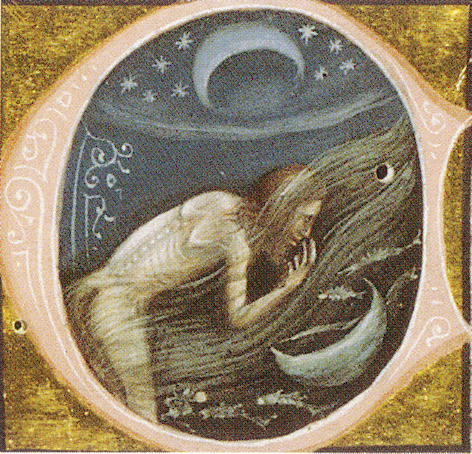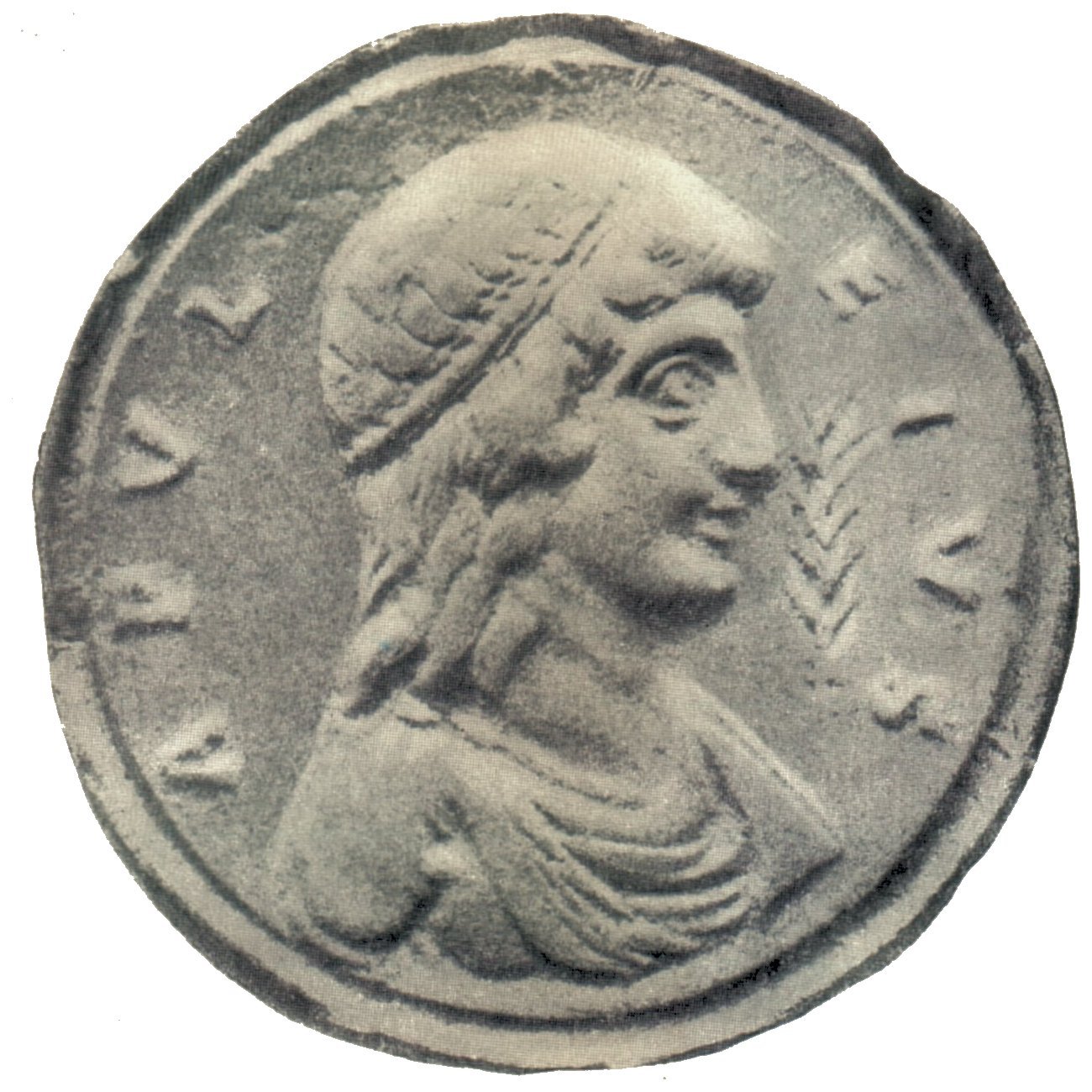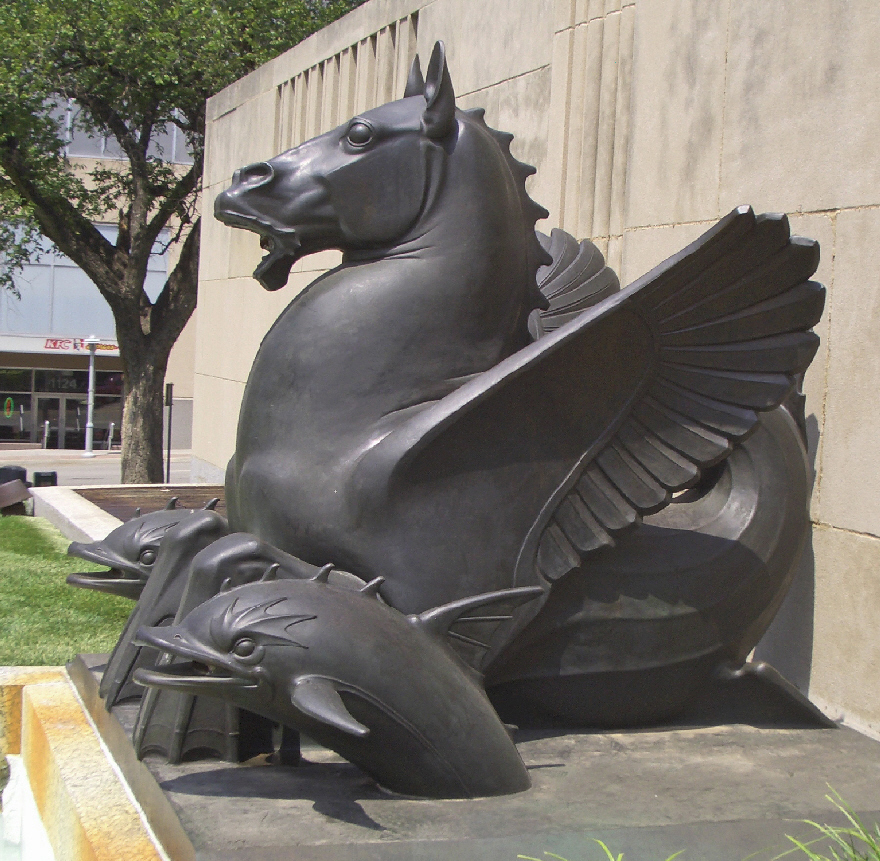|
Salacia (mythology)
In ancient Roman mythology, Salacia ( , ) was the female divinity of the sea, worshipped as the goddess of salt water who presided over the depths of the ocean. Neptune was her consort. That Salacia was the consort of Neptune is implied by Varro, and is positively affirmed by Seneca, Augustine and Servius. She is identified with the Greek goddess Amphitrite, consort of Poseidon, or Tethys who was also a marine deity. The god Neptune wanted to marry Salacia, but she was in great awe of her distinguished suitor, and to preserve her virginity, with grace and celerity she managed to glide out of his sight, and hid from him in the Atlantic Ocean. The grieving Neptune sent a dolphin to look for her and persuade the fair nymph to return and share his throne. Salacia agreed to marry Neptune and the King of the Deep was so overjoyed at these good tidings that the dolphin was awarded a place in the heavens, where he now forms a well known constellation Delphinus. Salacia is represent ... [...More Info...] [...Related Items...] OR: [Wikipedia] [Google] [Baidu] |
Centaur
A centaur ( ; ; ), occasionally hippocentaur, also called Ixionidae (), is a creature from Greek mythology with the upper body of a human and the lower body and legs of a horse that was said to live in the mountains of Thessaly. In one version of the myth, the centaurs were named after Centaurus (Greek mythology), Centaurus, and, through his brother Lapithes (hero), Lapithes, were kin to the legendary tribe of the Lapiths. Centaurs are thought of in many Greek myths as being as wild as untamed horses, and were said to have inhabited the region of Magnesia (regional unit), Magnesia and Mount Pelion in Thessaly, the Foloi oak forest in Ancient Elis, Elis, and the Malean peninsula in southern Laconia. Centaurs are subsequently featured in Roman mythology, and were familiar figures in the medieval bestiary. They remain a staple of modern fantastic literature. Etymology The Greek word ''kentauros'' is generally regarded as being of obscure origin. The etymology from ''ken'' + ''tau ... [...More Info...] [...Related Items...] OR: [Wikipedia] [Google] [Baidu] |
Maurus Servius Honoratus
Servius, distinguished as Servius the Grammarian ( or ), was a late fourth-century and early fifth-century grammarian. He earned a contemporary reputation as the most learned man of his generation in Italy; he authored a set of commentaries on the works of Virgil. These works, ("Exposition on Three Works of Virgil"), ("Commentaries on Virgil"), ("Commentaries on the Works of Vergil"), or ("Commentaries on the Poems of Virgil"), constituted the first incunable to be printed at Florence, by Bernardo Cennini, in 1471. In the ''Saturnalia'' of Macrobius, Servius appears as one of the interlocutors; allusions in that work and a letter from Symmachus to Servius indicate that he was not a convert to Christianity. Name The name Servius also appears as Seruius owing to the unity of the Latin letters V and U from antiquity until as late as the 18th century. Many medieval manuscripts of Servius's commentaries give him the praenomen Marius or Maurus and the cognomen Honoratu ... [...More Info...] [...Related Items...] OR: [Wikipedia] [Google] [Baidu] |
Roman Goddesses
The Roman deities most widely known today are those the Romans identified with Greek counterparts, integrating Greek myths, iconography, and sometimes religious practices into Roman culture, including Latin literature, Roman art, and religious life as it was experienced throughout the Roman Empire. Many of the Romans' own gods remain obscure, known only by name and sometimes function, through inscriptions and texts that are often fragmentary. This is particularly true of those gods belonging to the archaic religion of the Romans dating back to the era of kings, the so-called "religion of Numa", which was perpetuated or revived over the centuries. Some archaic deities have Italic or Etruscan counterparts, as identified both by ancient sources and by modern scholars. Throughout the Empire, the deities of peoples in the provinces were given new theological interpretations in light of functions or attributes they shared with Roman deities. A survey of theological groups as ... [...More Info...] [...Related Items...] OR: [Wikipedia] [Google] [Baidu] |
120347 Salacia
Salacia (minor-planet designation: 120347 Salacia) is a large trans-Neptunian object (TNO) and possible dwarf planet in the Kuiper belt, approximately in diameter. It was discovered on 22 September 2004, by American astronomers Henry G. Roe, Henry Roe, Michael E. Brown, Michael Brown and Kristina Barkume at the Palomar Observatory in California, United States. Salacia orbits the Sun at an average distance that is slightly greater than that of Pluto. It was named after the Roman goddess Salacia (mythology), Salacia and has a single known moon, Actaea (moon), Actaea. Orbit Salacia is a non-resonant object with a moderate eccentricity (0.11) and large inclination (23.9°), making it a scattered disc, scattered–extended object in the classification of the Deep Ecliptic Survey and a classical Kuiper belt object#Orbits: 'hot' and 'cold' populations, hot classical Kuiper belt object in the classification system of Gladman ''et al.'', which may be the same thing if they are part o ... [...More Info...] [...Related Items...] OR: [Wikipedia] [Google] [Baidu] |
Venilia
Venilia (pronounced , or as Latin ''Venīlia'') is a Roman deity associated with the winds and the sea. According to Virgil and Ovid, she was a nymph, the sister of Amata and the wife of Janus (or Faunus), with whom she had three children: Turnus Turnus () was the legendary King of the Rutuli in Roman history, and the chief antagonist of the hero Aeneas in Virgil's ''Aeneid''. According to the ''Aeneid'', Turnus is the son of Daunus and the nymph Venilia and is brother of the nymph ..., Juturna, and Canens. She and Salacia are the ''paredrae'' of Neptune. The Venilia Mons, a mountain on Venus, is named for her. See also * '' Pantoporia venilia'', a butterfly of the family Nymphalidae * '' Terebra venilia'', a species of sea snail References Roman goddesses Sky and weather goddesses Sea and river goddesses Neptune (mythology) {{AncientRome-myth-stub ... [...More Info...] [...Related Items...] OR: [Wikipedia] [Google] [Baidu] |
Aulus Gellius
Aulus Gellius (c. 125after 180 AD) was a Roman author and grammarian, who was probably born and certainly brought up in Rome. He was educated in Athens, after which he returned to Rome. He is famous for his ''Attic Nights'', a commonplace book, or compilation of notes on grammar, philosophy, history, antiquarianism, and other subjects, preserving fragments of the works of many authors who might otherwise be unknown today. Name Medieval manuscripts of the ''Noctes Atticae'' commonly gave the author's name in the form of "Agellius", which is used by Priscian; Lactantius, Servius and Saint Augustine had "A. Gellius" instead. Scholars from the Renaissance onwards hotly debated which one of the two transmitted names is correct (the other one being presumably a corruption) before settling on the latter of the two in modern times. Life The only source for the life of Aulus Gellius is the details recorded in his writings. Internal evidence points to Gellius having been born between A ... [...More Info...] [...Related Items...] OR: [Wikipedia] [Google] [Baidu] |
The Golden Ass
The ''Metamorphoses'' of Apuleius, which Augustine of Hippo referred to as ''The Golden Ass'' (Latin: ''Asinus aureus''), is the only ancient Roman novel in Latin to survive in its entirety. The protagonist of the novel is Lucius. At the end of the novel, he is revealed to be from Madauros, Madaurus, the hometown of Apuleius himself. The plot revolves around the protagonist's curiosity (''curiositas'') and insatiable desire to see and practice magic. While trying to perform a spell to transform into a bird, he is accidentally transformed into an donkey, ass. This leads to a long journey, literal and metaphorical, filled with The Golden Ass#Inset stories, inset tales. He finally finds salvation through the intervention of the goddess Isis, whose cult he joins. Origin The date of composition of the ''Metamorphoses'' is uncertain. It has variously been considered by scholars as a youthful work preceding Apuleius' ''Apology'' of 158–159, or as the climax of his literary career, an ... [...More Info...] [...Related Items...] OR: [Wikipedia] [Google] [Baidu] |
Apuleius
Apuleius ( ), also called Lucius Apuleius Madaurensis (c. 124 – after 170), was a Numidians, Numidian Latin-language prose writer, Platonist philosopher and rhetorician. He was born in the Roman Empire, Roman Numidia (Roman province), province of Numidia, in the Berbers, Berber city of Madauros, modern-day M'Daourouch, Algeria. He studied Platonism in Athens, travelled to Roman Italy, Italy, Asia (Roman province), Asia Minor, and Egypt (Roman province), Egypt, and was an initiate in several cults or Greco-Roman mysteries, mysteries. The most famous incident in his life was when he was accused of using magic to gain the attentions (and fortune) of a wealthy widow. He declaimed and then distributed his own defense before the proconsul and a court of magistrates convened in Sabratha, near Oea (modern Tripoli, Libya, Tripoli, Libya). This is known as the ''Apologia''. His most famous work is his bawdy picaresque novel the ''Metamorphoses'', otherwise known as ''The Golden Ass''. It ... [...More Info...] [...Related Items...] OR: [Wikipedia] [Google] [Baidu] |
Nereids
In Greek mythology, the Nereids or Nereides ( ; ; , also Νημερτές) are sea nymphs (female spirits of sea waters), the 50 daughters of the 'Old Man of the Sea' Nereus and the Oceanids, Oceanid Doris (Oceanid), Doris, sisters to their brother Nerites (mythology), Nerites. They often accompany Poseidon, the god of the sea, and can be friendly and helpful to sailors (such as the Argonauts in their search for the Golden Fleece). Name It is not known whether the name Nereus was known to Homer or not, but the name of the Nereids is attested before it, and can be found in the ''Iliad''.; ; Since Nereus only has relevance as the father of the Nereids, it has been suggested that his name could actually be derived from that of his daughters; while the derivation of the Nereids from Nereus, as a patronymic, has also been suggested. According to Martin Litchfield West (1966), Nereus is much less important than his daughters, mentioning that Herodotus offered "the Nereids, not Nereu ... [...More Info...] [...Related Items...] OR: [Wikipedia] [Google] [Baidu] |
Triton (god)
Triton (; ) is a Greek mythology, Greek god of the sea, the son of Poseidon and Amphitrite. Triton lived with his parents in a golden palace on the bottom of the sea. Later he is often depicted as having a conch shell he would blow like a trumpet. Triton is usually represented as a merman, with the upper body of a human and the tailed lower body of a fish. At some time during the Greek and Roman era, Triton(s) became a generic term for a merman (mermen) in art and literature. In English literature, Triton is portrayed as the messenger or herald for the god Poseidon. Triton of Lake Tritonis of ancient Libya is a namesake mythical figure that appeared and aided the Argonauts. Moreover, according to Apollonius Rhodius, he married the Oceanids, Oceanid of the said region, Libya (Greek myth), Libya. Sea god Triton was the son of Poseidon and Amphitrite according to Hesiod's ''Theogony''. He was the ruler (possessor) of the depths of the sea, who is either "dreadful" or "mighty" () ... [...More Info...] [...Related Items...] OR: [Wikipedia] [Google] [Baidu] |
Hippocamp
The hippocampus, or hippocamp or ''hippokampos'' (plural: hippocampi or hippocamps; , from , and Word origin of ''Hippocampus'' at reference.com; compare the monster Campe.), sometimes called a "sea-horse" in English, is a mythological creature mentioned in Etruscan, |
Delphinus
Delphinus is a small constellation in the Northern Celestial Hemisphere, close to the celestial equator. Its name is the Latin version for the Greek word for dolphin (). It is one of the 48 constellations listed by the 2nd-century astronomer Ptolemy, and remains one of the 88 modern constellations recognized by the International Astronomical Union. It is one of the smaller constellations, ranked 69th in size. Delphinus' five brightest stars form a distinctive asterism symbolizing a dolphin with four stars representing the body and one the tail. It is bordered (clockwise from north) by Vulpecula, Sagitta, Aquila, Aquarius, Equuleus and Pegasus. Delphinus is a faint constellation with only two stars brighter than an apparent magnitude of 4, Beta Delphini (Rotanev) at magnitude 3.6 and Alpha Delphini (Sualocin) at magnitude 3.8. Mythology Delphinus is associated with two stories from Greek mythology. According to myth, the first Greek god Poseidon wanted to marry Amphitrite, ... [...More Info...] [...Related Items...] OR: [Wikipedia] [Google] [Baidu] |









